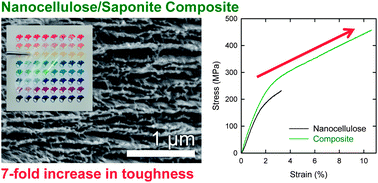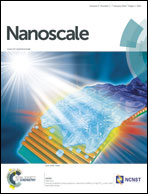Highly tough and transparent layered composites of nanocellulose and synthetic silicate†
Abstract
A highly tough and transparent film material was prepared from synthetic saponite (SPN) nanoplatelets of low aspect ratios and nanofibrillar cellulose. The nanofibrillar cellulose was chemically modified by topological surface oxidation using 2,2,6,6-tetramethylpiperidinyl-1-oxyl (TEMPO) as a catalyst. Both synthetic SPN nanoplatelets and TEMPO-oxidized cellulose nanofibrils (TOCNs) have abundant negative charges in high densities on their surfaces and are dispersed in water at the individual nanoelement level. Layered nanocomposite structures of the SPN nanoplatelets and TOCNs were formed through a simple cast-drying process of the mixed aqueous dispersions. The TOCN/SPN composites with 0–50% w/w SPN content were optically transparent. Mechanical properties of the TOCN/SPN composites varied depending on the SPN content. The composite with 10% w/w SPN content (5.6% volume fraction) exhibited characteristic mechanical properties: Young's modulus of 14 GPa, tensile strength of 420 MPa, and strain-to-failure of 10%. The work of fracture of the composites increased from 4 to 30 MJ m−3 – or by more than 700% – as the SPN content was increased from 0 to 10% w/w. This surprising improvement in toughness was interpreted based on a model for fracture of polymer composites reinforced with low-aspect-ratio platelets.


 Please wait while we load your content...
Please wait while we load your content...